Menus

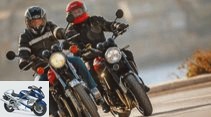
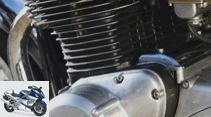
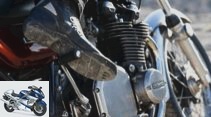

27 photos
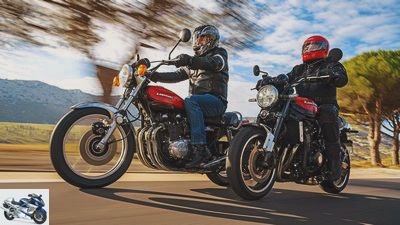
1/27
On the move with the Kawasaki Z1 and the Kawasaki Z 900 RS.

2/27
The similar-looking, yet so different Kawas curve amicably through southern France.

3/27
When DOHC was still something special: The Z1 engine emphasizes its two overhead camshafts with aluminum-colored covers.
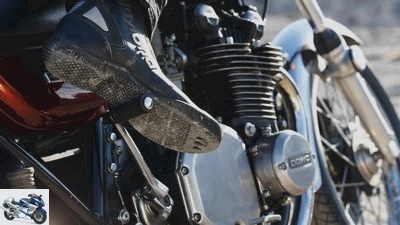
4/27
Still useful for the first piston strokes before the morning cold start: the kick starter of the Z1.
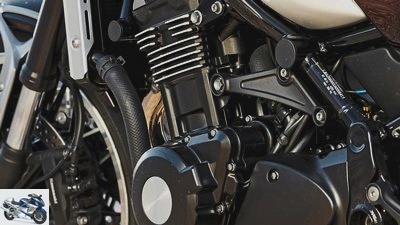
5/27
The homage to the historical model is unmistakable: decorative cooling ribs and crescents on the valve cover in natural aluminum.
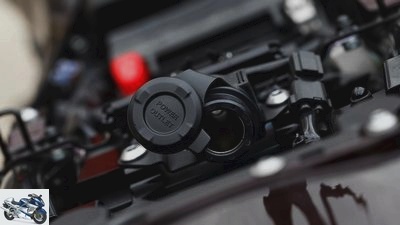
6/27
The Z 900 RS has a socket for charging smartphones or operating navigation devices.

7/27
Because of the brute acceleration of the Z 900, Franz-Josef Scherner gave it the nickname in the 1976 MOTORRAD test "Frankenstein’s daughter".

8/27
Instruments cannot be made more readable. There is space for a key fob in the hole above the ignition lock.
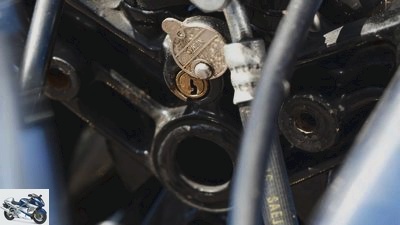
9/27
A central steering lock, operated from below.
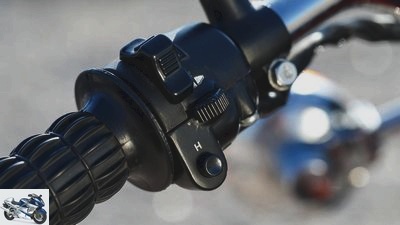
10/27
Horn, indicators, high beam switch – there is nothing more to operate on the left end of the handlebar.
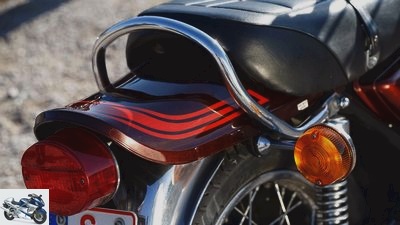
11/27
The long, curved tail rump determines the lines of the Z1 decisively.
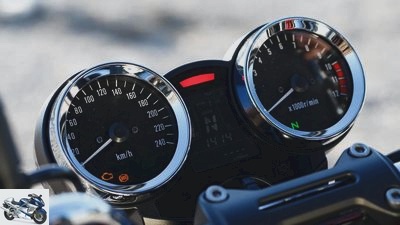
12/27
The typography of the digits and the position of the hands on the Z 900 RS are the same as those of the Z1.
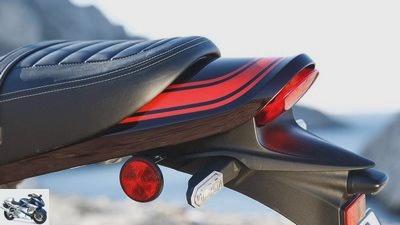
13/27
Because the total length of the RS is shorter than that of the Z1, the rump is also shorter.
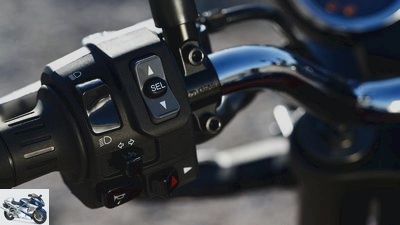
14/27
The left thumb has more to do, but the operation of the RS remains uncomplicated.
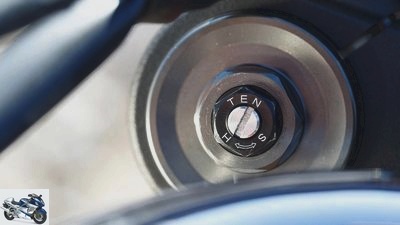
15/27
The attractive fork of the RS is adjustable.
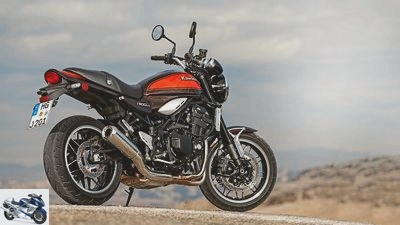
16/27
It would be wrong to see an imperfect replica of the Z1 in the RS. It is a modern motorcycle with classic shapes.
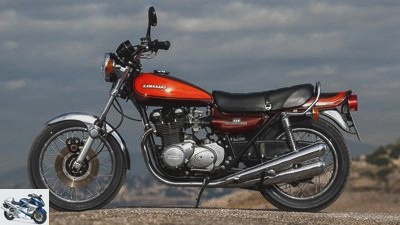
17/27
While the teardrop-shaped tank merges into the body of the RS, the Z1 still stands on its own.
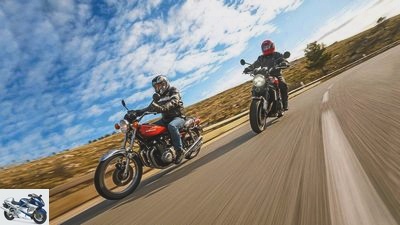
18/27
The difference over the years can also be clearly seen in the price. While 7200 marks were due for the Z1 in 1972, 11,995 euros are put on the table for the RS.
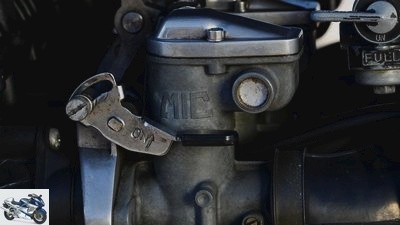
19/27
The Mikuni round slide carburetors need attention.

20/27
The oil reservoir for lubricating the chain: no longer necessary with modern X-ring chains.
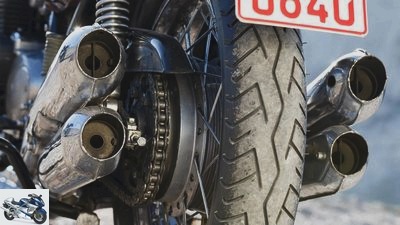
21/27
The four-in-four exhaust system enjoys almost cultic admiration. To the amazement of the author.

22/27
Dark in timbre, strong in tone, but always subtle in volume: the RS four-in-one damper.
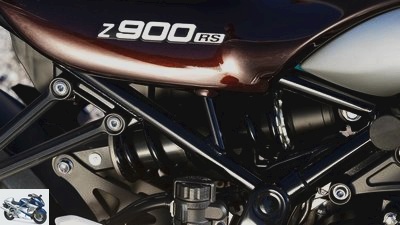
23/27
The rear wheel suspension of the RS is characterized by excellent damping and sensitive response.
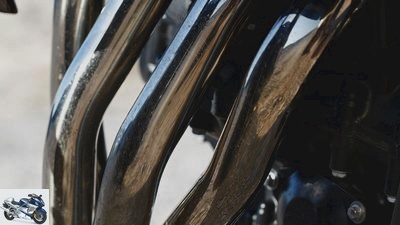
24/27
The stainless steel elbows of the RS are highly polished.

25/27
Franz-Josef Schermer: One of the first testers of the Kawasaki Z1 in Germany.
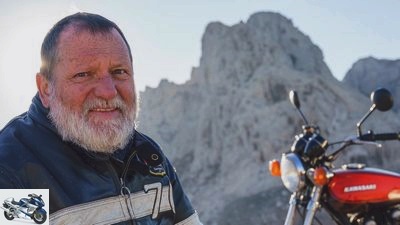
26/27
Peter Krauss: Z collector and driver, President of the Z Club Germany.

27/27
Whether new or old, they are both beautiful.
Kawasaki Z1 and Kawasaki Z 900 RS
Generation comparison
Content of
Every family is shaped by continuity and generation conflicts. How about two Kawasakis from different eras, the Z1 from 1972 and its descendant Z 900 RS?
KJust before Christmas, four men and two motorcycles travel to the south of France, whose mission actually shows some parallels to “Frankenstein Junior”. Peter Krauss, the President of Z-Club Germany, plays a similar role as trustee of the old Z-Kawasaki as Mrs. Blucher in Mel Brooks ‘film.
Buy complete article

Kawasaki Z1 and Kawasaki Z 900 RS
Generation comparison
The honorary name "Frankenstein’s daughter"
Franz-Josef Schermer, whose test of the Z 900 appeared in MOTORRAD 4/1976 under the heading “Frankenstein’s Daughter” and who thus created an honorary name for all Z-Kawas of the 1970s, should not be missing. In his career as a motorcycle journalist, he has always kept pace with the latest developments and is a vehement advocate of the new Z 900 RS. As a counterpart to Frederick Frankenstein, who was critical of his grandfather’s experiments and therefore insisted on pronouncing his surname “Fronkensteen”.
Our photographer Jorg Kunstle embodies the obvious parallel to cameraman Gerald Hirschfeld. I am most likely to find myself in the figure of the factotum Igor, although I don’t have the bulging-eyed physiognomy of Marty Feldman and I haven’t dropped anything as important as the brain of a scientist that should have been brought back to life. Luckily.
The four-in-four exhaust system enjoys almost cultic admiration. To the amazement of the author.
And then there are the motorcycles. Seen objectively, they are technical devices, but for many of their drivers they are actually considered to be animated beings. Similar to the assembled people of the Frankensteins. It takes a while until the Z1 has coughed the sleepiness of several months of idle time out of the combustion chambers and filming, i.e. photo trips, can begin. In the hinterland of the French Mediterranean coast between Bandol and Marseille, the engine is freed and the tires started; One cruises in harmony through the landscape, which even at the end of December offers many promises of future, warmer days again.
The harmony holds, also because the Z 900 RS leaves the grand entrance to the expressive old man. The starter yelp, the first rumble of the ignition, the slightly hoarse trumpeting through the four mufflers, the subtle roughness of the roller-bearing crankshaft and the squeaking of the brakes, which is pleasantly heard less and less with a longer journey – the whole “grande commedia” of the old folks accompanies the Z 900 RS with friendliness Service, strong but subtle tone, impeccable running culture and almost perfect functionality. Not only is her almost new condition expressed, 45 years of development, refinement and improvement also manifest themselves in all conceivable aspects.
A place directly on the coast offers the opportunity to put the extremely different details of the two Kawasakis in the right light and in the picture, despite their external similarity. Here – standing up, of all places – the Z1 finally comes into great shape, here it finds its audience in the form of strollers from nearby Marseille, who actually came here to enjoy the sunny day. An older man owned a Z1 himself in the 1970s, takes a quick look at the Z 900 RS and quickly agrees with Peter, who speaks French, that the Z1 is more beautiful than the recently launched Z 900 RS. The four-in-four instead of the four-in-one exhaust system, the wire-spoke wheels with the chrome-plated rims instead of the cast wheels, the two spring struts instead of the mono spring strut with a lever system that opens a gap between the rear tire and the rear section of the Z 900 RS – yes, if the new one still had all this … But so, no, he wouldn’t buy the RS, says the Frenchman. Peter, who has only driven the Z1 so far, wants to drive the Z 900 RS at least once before he judges.
View motorcycle vs. motorcycling
While I hold the reflector for Jorg to lighten the shadow areas on the RS, I quietly listen to the conversation until I can no longer stand it and fall out of my role as a factotum. The question literally bursts out of my mind: Is watching a motorcycle actually that much more important than riding a motorcycle? Or asked the other way around, why they wanted to make a very good new motorcycle worse, with a heavier, less efficient exhaust system, with heavier wheels that deteriorate handling and comfort, and a rear suspension whose potential is clearly limited?
There is silence for a few seconds. I have probably just disrupted the beginning of a wonderful friendship with men in matters of Z-Kawa, but in any case gave me cause for thought. Because the answer slowly feels its way along a train of thought that one has probably not followed often: Yes, the appearance of a motorcycle is very important and the restrictions that might come with the transformation of the Z 900 RS into a kind of Z1 RS would be anyway only people like me notice.
Unrealistic journalists?
I immediately agree with the first part of this answer. Everyone should decide for themselves what they see in a motorcycle and do with it. But this “people like you” bothers me a lot. As if all those who test for motorcycle, tire, brake, spring element and other component manufacturers or even for trade magazines belonged to an unreal caste of super drivers. Spoiled by ever new motorcycles, hypersensitive to every hundredth of a millimeter of tire wear, the mice whistle and the grass grows hearing and all of them are real or disguised racing drivers. The thing about the racing drivers is mostly true, but the other is not.
Due to the year-round test operation, “people like you”, including the former racing driver Franz-Josef, may have more routine. The much greater privilege of people like us, however, is to be able to compare directly. “Normal” motorcyclists rarely get this opportunity; they get used to the gradual changes in their machines, which rarely lead to improvements. Most of them would, however, feel the differences if they could drive two same motorcycles in direct succession with bikes of different weights.
The discussion about it occupies Peter and me again and again between the photo trips and the drive home, at dinner it really flares up. Franz-Josef, “Franz” usually stays out of the conversation. As before, he prefers to be a careful tester, counting the links in the drive chains, enjoying the sun and – as he finally throws in briefly and dryly – “every kilometer on the motorcycle, regardless of which one”.
Whether new or old, they are both beautiful.
In this way he stops the heated discussion and provides a nice script for the following day. Sunny phases alternate with short rain showers, but there are enough dry and winding roads for hearty motorcycling. We exchange motorcycles and driving impressions, pay a visit to the favorite pass of the MOTORCYCLE testers and pay our reference to Circuit Paul Ricard, which looks very different today than Franz knows it. Peter mainly has to criticize service stories about the Z 900 RS; he wants a folding bench seat and would like to have easier access to the spark plugs and the air filter. Not unreasonable in view of a candle change interval of 12,000 kilometers; the only question is why iridium candles of the same type in various current Hondas only have to be changed after 48,000 kilometers?
Objectively, regardless of the appearance, speaks against the RS in the eyes of the Z fans of old shot and grain, especially the too short seat, on which the driver and passenger inevitably come very close. In these matters, the Z1 is more suitable for everyday use, offers more space and allows easier access to service-relevant parts. However, she also needs more attention to stay in shape, even if the hardware, sorry, all the units are in optimal condition.
In addition, we experience the Z1 as a speedy motorcycle, provided that the driver lets it run through the curves on gently rounded lines. The chunk, which is noticeably heavy when standing, can be swiveled easily through the angular mechanism thanks to the wide handlebars and narrow tires. Franz misses the typical acceleration in the back to which the Z-Kawas of yore owe their names of honor, mixed with a slight horror. I, on the other hand, like how much temperament the old engine has regained over the course of around 400 kilometers. The unavoidable swing of the hip when deflecting in an inclined position suggests that the swing arm mounting and suspension struts are no longer in a 100% condition, but they are not particularly annoying. And just like the four-cylinder, the brakes show that they grow with the demands placed on them – within the scope of their possibilities. The Z1 doesn’t just want to be seen as a sculpture, it also wants to be challenged as a driving machine.
Either way, the longer we drive, the more clearly I see that the old and new Z are not comparable, although Kawasaki provokes such comparisons. But if you only see an imperfect replica of the Z1 in the Z 900 RS or blame the Z1 for not being so spontaneous on the gas, cracking so powerfully and driving as stable as the RS, you should stay in its respective era. However, this deprives him of an important and valuable experience: good motorcycles have always been characterized by their balance, by a coherent overall concept that combines all character traits in harmony. Whether a brake is better or less controllable, a motor has more or less power, is then almost a minor matter and owed to the state of the art in the respective epoch. In this sense both Kawasakis, the Z1 and the Z 900 RS, are indeed very good motorcycles.
Opinions
Franz-Josef Schermer – One of the first testers of the Kawasaki Z1 in Germany.
The Z1 was an epoch-making motorcycle, no question about it. And the Z 900 RS is one of the most important motorcycles of the moment. She impressed me right away. The injection engine with balancer shaft and 16 valves pulls, turns and does exactly what I tell it to do with the throttle. The chassis is also great, precise turning, precise lines and high driving stability are a matter of honor. And how it roars the RS, unbelievable. Not loud, not intrusive, but clear. That sound is Kawasaki. I’m not looking for the good old days, it’s over once and for all. But riding a motorcycle is still nice.
Peter Krauss – Z-collector and -driver, President of the Z-Club Germany
I too can only congratulate Matsumura-San, the project manager for the Z 900 RS. The RS looks good, its engine and chassis offer me a previously unknown driving pleasure. However, I would like it with a chrome-plated four-in-four exhaust system, a mounting bracket for my pillion passenger and a neatly fitted luggage rack. My wife and I are still on a camping holiday together with the motorcycle, but we would also need a longer bench seat and lower social pegs. Still, if I don’t win a Z 900 RS at Motorcycle of the Year, I’ll probably buy one.
Related articles
-
Kawasaki Z 900 in the driving report
Kawasaki 17th photos Kawasaki 1/17 Kawasaki Z 900 Kawasaki 2/17 Dipped in bright green, the new tubular steel lattice frame accommodates the engine as a…
-
On the move: Benelli 750 Sei, Honda CBX 1000, Kawasaki Z 1300
Bilski 17th photos Bilski 1/17 Who is the widest in the whole country? The angle of spread of the driver’s legs provide information. Bilski 2/17 With…
-
Kawasaki Ninja H2 in the top test
Bilski 26th photos Bilski 1/26 With 218 hp, the H2 is the most powerful bike on the MOTORRAD test bench to date. Bilski 2/26 The polished stainless steel…
-
Kawasaki premiere: Kawasaki ZX-6R The 636 ninja from Kawasaki Content of traction control, two power modes, ABS – the 600 series are …
-
Ducati 1299 Panigale S and Kawasaki Ninja H2 in comparison test
31 pictures 1/31 Left in the picture 197 HP and 145 Nm (Ducati 1299 Panigale S), on the right there are 200 HP and 133 Nm (Kawasaki Ninja H2) ….
-
First driving report of the Kawasaki GPZ 900 R (MOTORRAD 1-1984)
Archive 26 pictures Archive 1/26 Light, strong and fast was the formula for the Kawasaki superbike of the 1980s, the GP Z 900 R. Archive 2/26 According to …
-
Air-cooled big bikes Kawasaki GPZ 1100 UT, Laverda RGS 1000 and Suzuki GSX 1100 EF
fact 48 pictures fact 1/48 The engines are the stars, they still exude charm and, in the case of GPZ, RGS and GSX, clearly inspire …
-
BMW, Kawasaki, Triumph and Yamaha Tourer in comparison test
Gargolov 31 photos Gargolov 1/31 Tourer comparison test: Triumph Trophy SE, BMW R 1200 RT, BMW K 1600 GT, Yamaha FJR 1300 and Kawasaki 1400 GT. Gargolov…
-
Kawasaki Z 1000 SX in the driving report
Photo: Kawasaki 11 photos Kawasaki 1/11 The LED headlights are part of the new front fairing. They should shine brighter and wider at the same time….
-
Trip with the Kawasaki Z 750 B
www. 23 photos 1/23 2/23 3/23 4/23 5/23 6/23 7/23…